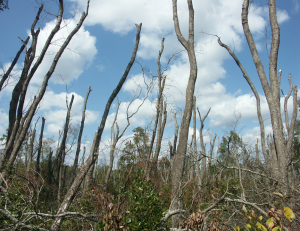Assessing genetic variation of forest tree species at risk

Eastern hemlock, South Mountains State Park, North Carolina
SUMMARY: Many forest tree species and populations face serious threats to their long-term viability, most seriously from insect and disease infestation and from the effects of climate change. To conserve the genetic foundation tree species need to survive and adapt in the face of these threats, forest management decisions must consider how genetic diversity is distributed across species’ ranges. A cooperating scientist from North Carolina State University (NCSU) is the lead analyst for several range-wide genetic variation studies of species which are being decimated by exotic insects, including eastern hemlock and Carolina hemlock, and ponderosa pine, a species with isolated populations of special concern given their susceptibility to climate change, development, and bark beetles.
Results from studies on these species are already influencing management decisions. Characterization of the genetic diversity and structure of the two hemlock species is guiding NSCU-based Camcore conservation cooperative’s seed collections from genetically significant hemlock populations. After the ponderosa pine study uncovered evolutionary relationships among species varieties and assesses genetic variation of several small and isolated populations, the Bureau of Land Management is utilizing results for management activities in the western United States. The Forest Service’s National Forest System will also use study results to help guide gene conservation and seed transfer strategies. The results from these studies have also been used to make more realistic predictions of future environmental suitability for ponderosa pine and eastern hemlock by generating separate projections for different evolutionary lineages within the species, each of which may have evolved to adapt to different environmental conditions.
PROGRESS: The range-wide genetic variation study of eastern hemlock, using polymorphic microsatellite markers, was published in 2012. Researchers are using the results of this study to assess long-term genetic risk to eastern hemlock populations, and to identify populations most in need of gene conservation. A paper published in 2017, with a researcher from the Northern Research Station, examines climatic differences among eastern hemlock evolutionary lineages, and projects potential suitable habitat for each under climate change. A different paper in 2017 found that Carolina hemlock populations are surprisingly genetically isolated from each other and inbred, adding to the urgency of conserving the species.
Mitochondrial DNA haplotypes were identified from more than 100 ponderosa pine populations, allowing researchers to detect long-term genetic divergence among groups of populations. A journal article describing these results was published in 2013. Microsatellite marker and isozyme protein marker work further assessed genetic variation among ponderosa pine populations, and was published in 2015. A paper published in 2016 examined climatic differences among ponderosa pine evolutionary lineages, and “hindcasted” climate conditions for each to the peak of the Pleistocene glacial period, approximately 22,000 years ago. A paper published in 2018 projected the future potential distributions of these evolutionary lineages while accounting for climatic change.
A new project is under way to assess patterns of genetic diversity and structure in an uncommon and declining Appalachian tree species, Table Mountain pine (Pinus pungens). Previously published work focused on other at-risk forest tree species, including the Southern Appalachian endemic Fraser fir (Abies fraseri) and pine species from Mexico and central America.
A review paper outlining the challenges and opportunities of forest tree gene conservation was published in 2017 as the introduction for a special issue of the journal New Forests on conservation genetics of forest trees.
This research has been described in a number of papers and presentations.
LINKS:
- “Conserving Eastern Hemlock: Combining Genetics and Climate Change Models to Assess Conservation Needs“
- “Carolina Hemlock Populations: Isolated and Imperiled“
- “Hemlock Seed Banking: Identifying Collection Locations for Future Hemlock Restoration“
- “Genetic Studies Reveal a Tree’s History to Ensure its Future“
CONTACT: Kevin Potter, NCSU Department of Forestry and Environmental Resources, kpotter@ncsu.edu or (919) 549-4071



